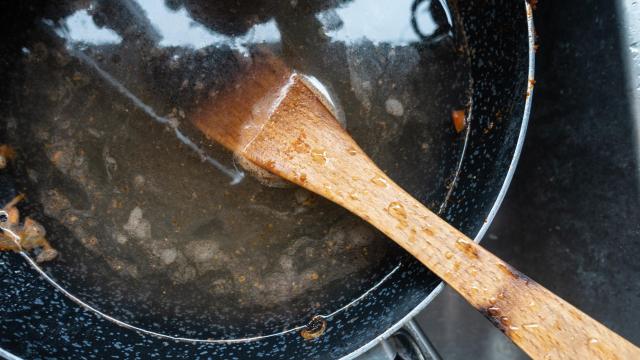“Soaking the dishes” has become shorthand for “not actually doing the dishes,” and for the most part, that’s accurate. Lots of people assume soap works like a solvent, so if you just fill a crusty pot with soapy water, it’ll magically dissolve — and the longer you let it sit, the better. Plot twist: The solvent in a dishwashing scenario is water, not soap or detergent, and like many solvents, water works best when it’s hot.
This is the real reason to wash your dishes with hot water. Your tap doesn’t get hot enough to kill bacteria — that’s what the soap is for — but the heat does help dissolve and dislodge whatever’s stuck on your dishes. It’s also why soaking a pot overnight never ends up working as well as you want it to: By morning, the steaming hot water you started out with is firmly room temperature, and its dissolving power has been greatly reduced. If you’re dealing with a mess that’s resisting a soapy sponge and elbow grease, a brief soak in very hot water is the only way to go. Here’s how to do it.
Fill your dish with the absolute hottest water your tap can put out, add a little soap if you like, and let it soak for a few minutes. Exact soaking times will vary depending on the size of the dish you’re dealing with: Smaller dishes hold less water and will therefore cool off faster, so they may only need one or two minutes, while big pots can hold heat for 10 or 15. The goal is to get your dish as hot as the water it holds, so as long as you don’t let it cool off, you’re good. While it soaks, do your other dishes or wipe down the counters or whatever else you need to do, then dump most of the soaking water out, add some soap to the remaining water, and get to scrubbing. The combination of a hot surface and concentrated soapy water should remove everything with ease.
If you’re still not having any luck, you may consider a “turbo soak:” Fill your pot or pan most of the way with water, then put it back on the stove and bring it to a boil. Cut the heat, let it sit for a few minutes, then carefully dump most of the water out. This time, add some soap and a little bit of cold water to bring the contents back to a temperature that won’t melt your skin off. (Safety first!) This technique will loosen even the stubbornest crusty gunk and free you from the tyranny of a sink full of “soaking” dishes.

Leave a Reply
You must be logged in to post a comment.